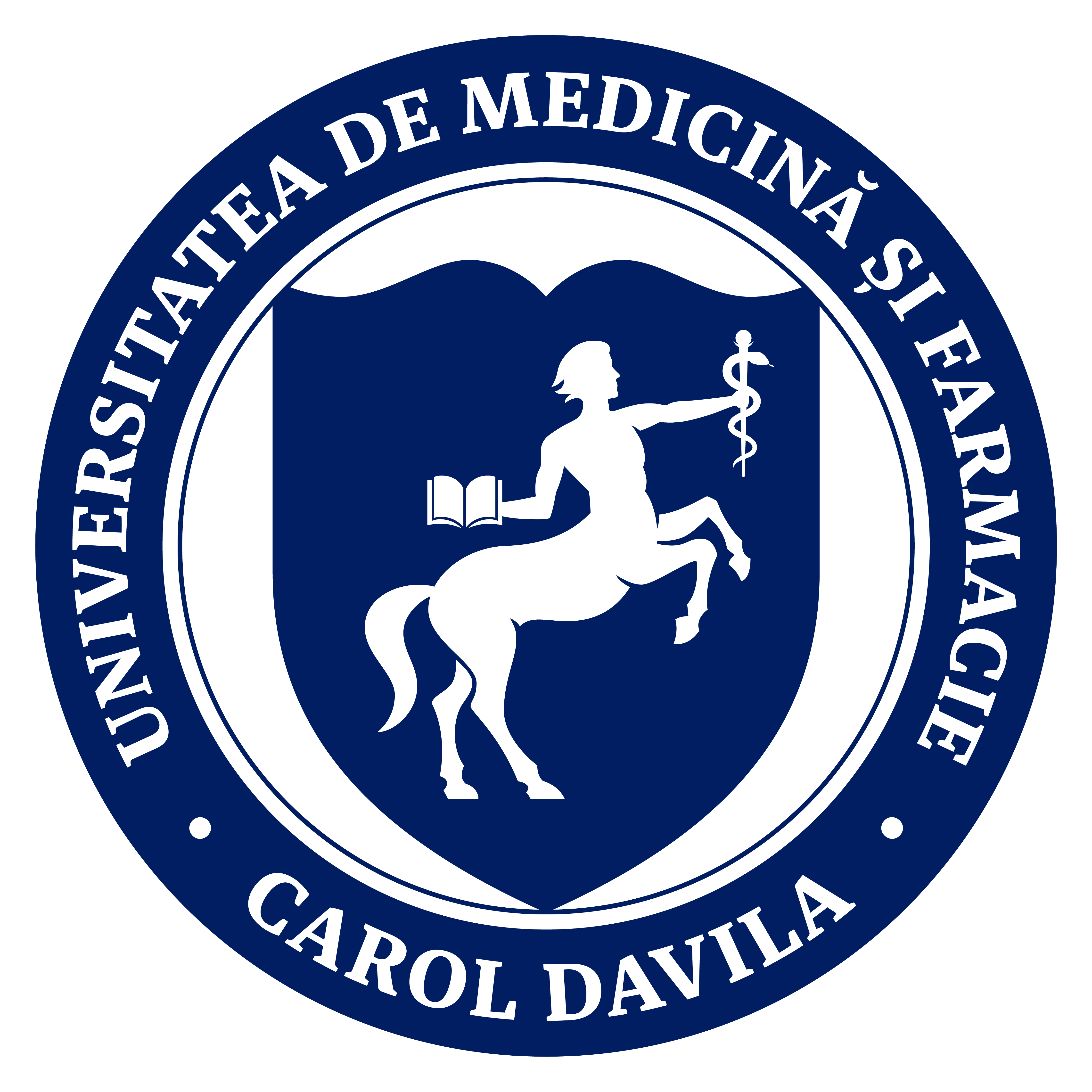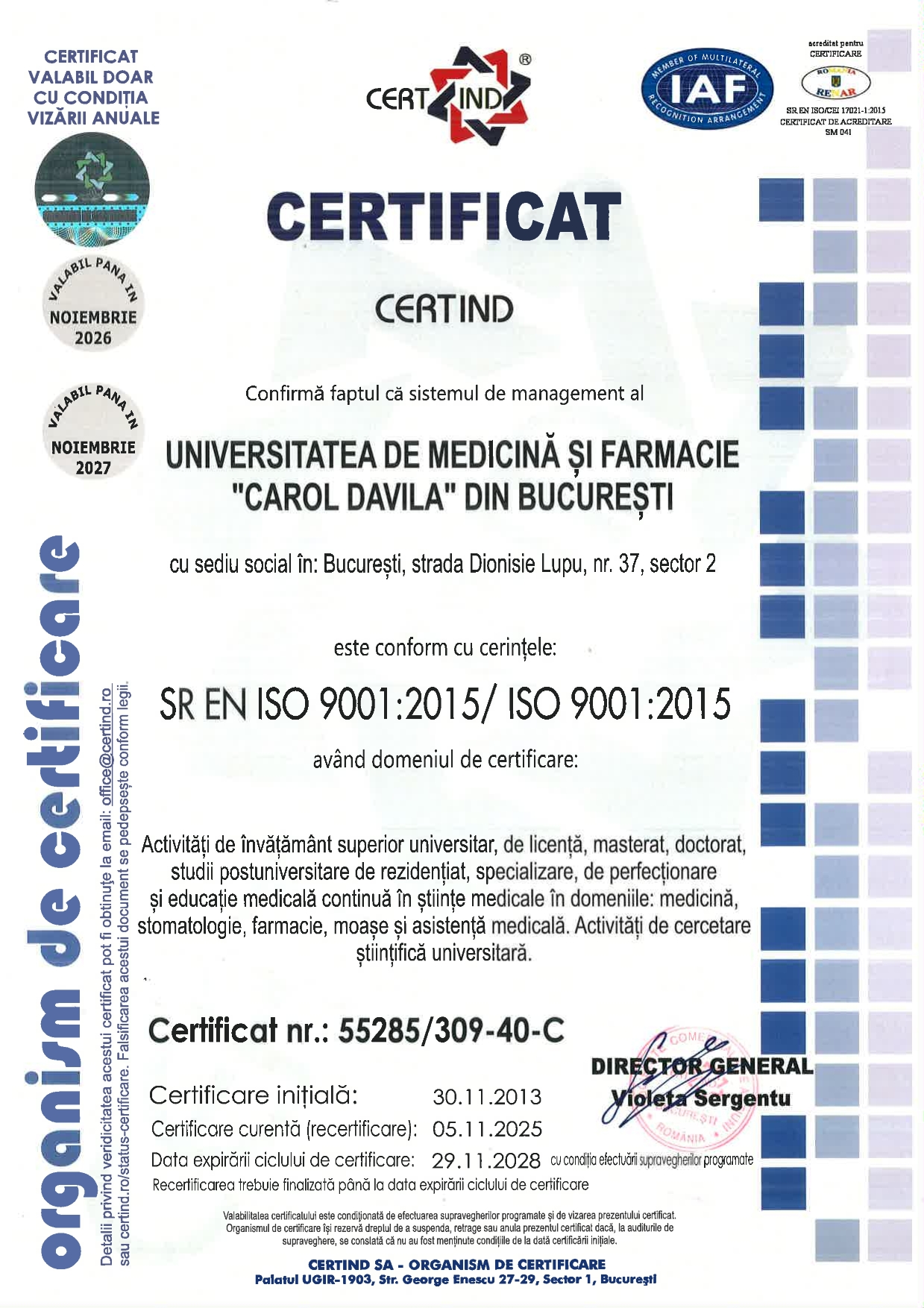Discipline - Medical Informatics and Biostatistics
- List of academic staff
- Brief history of the discipline
- Description of the medical activity
- Description of the teaching and research activity
- Useful information for students
- Useful information for residents
- Useful information regarding the postgraduate course
- Useful information for doctorate students
| Professor | Iliuta Luminita, PhD | tenured |
| Associate Professor | Poenaru Elena, PhD | tenured |
| Associate Professor | Panaitescu Eugenia, PhD | tenured |
| Head of works | Rac-Albu Marius, PhD | tenured |
| Head of works | Rac-Albu Elena Madalina, PhD | tenured |
| Assistant Professor | Suliman Emine, PhD | tenured |
| Assistant Professor | Camburu Georgiana, PhD | tenured |
| Assistant Professor | Dinescu Cristina Mirela, PhD | tenured |
| Assistant Professor | Petrescu Gheorghe Dodu, PhD | tenured |
In the spring of 1990, as a way of modernizing medical education, it was decided to introduce a new subject in the curriculum of the 2nd year, called "Medical Informatics".
For a few years, the teaching activity related to the discipline was carried out in improvised conditions, for practical courses using a primitive network of IBM-PC computers with 80286 processors, located in the building of the Filaret Hospital, together with the "Biostatistics" discipline.
The management of the Faculty decided in 1993 to move the network in the Faculty of Medicine, simultaneously establishing the Laboratory for students and a communication center in the Service for Information and Statistics of the University.
Since 1994, the archaic teaching lab computers have been replaced by a new generation (80386), and in 1996 a new laboratory was created ("Multimedia"), equipped with 12 80486 computers connected to the Internet. Obviously, the evolution of technology has made these computers become obsolete quickly, so in 2001 and then in 2003 the two laboratories' equipment was modernized.
Today, the Department of Medical Informatics and Biostatistics has a total of 30 "personal" computers, with performances high enough for teaching needs.
Given the fact that in the last decade of the last century there was no IT training for students in high schools, it was decided that the activities of Medical Informatics in the second year will be preceded by preparatory activities for general informatics for one semester in the first year of study.
We should mention that the former Medical Informatics laboratories were permanently used for (optional) seminar activities of Biostatistics.
As time passed, Romanian high school graduates began to be increasingly familiar with computer work. For this reason, in 2003, simultaneously with the merger of the former Department of Medical Informatics with the Biostatistics department, it was decided to reduce the volume of preparatory activities, familiarity with the computer, and replace them with related activities in the past classical biostatistics courses. For the same reason, in 2010 the volume of activities in the discipline of Medical Informatics and Biostatistics was reduced to its original level - a semester - from 1991.
In time, as noted above, the curriculum of laboratory activities has changed substantially and the discipline of Medical Informatics theme was permanently influenced by laboratory equipment. Thus, between 1991-1995 students were taught to use commands of the MS-DOS operating system (v. 4.01), edit texts and create diagrams using Works, control the management system of database dBase IV, exploit resources of a local area network using (Novell) Netware (v. 4) and using Epi Info software (v. 6), the latter for epidemiological reporting activities. Today all this seems ridiculous ...
Between 1995 and 2000, with the introduction of Windows computers in the lab, the students were taught first to use a GUI, then make publishing with (MS) Word and spreadsheets with (MS) Excel using this GUI. For databases, FoxPro began to be used, and Powerpoint for creating presentations. In addition, the study took a variant of the Linux operating system and, more increasingly, the Internet.
After 2000, the focus was on informing in the World Wide Web, the operation of statistical facilities in (MS) Excel relevant to the medical field, the control of new versions of Epi Info (2000, 2002 ...). There have been addressed, for limited periods, various other issues: familiarity with the software of the family doctor, then of the hospital, physiological signal processing issues, the issue of representation of medical knowledge in computerized medical decision support. Currently the "novelty" is the issue of medical imaging.
The main areas of interest to health professionals provided by the activities of the Department of Medical Informatics and Biostatistics are applied biostatistics in preclinical research, clinical and population health; applied computer sciences in biomedical and clinical disciplines and new trends related to population studies. Department of Medical Informatics and Biostatistics is thus the "meeting place" ideal for all teachers involved nationally and internationally in interdisciplinary research.
Biostatistics involves the development and application of statistical methods in scientific research in all fields related to health, including medicine, epidemiology and public health. Since the beginning of this century, biostatistics has become an indispensable tool for improving the health and reducing disease. Biostatisticians play an essential role in terms of design studies and analysis for various research issues. They help formulate scientific questions, determine the most appropriate sampling techniques, coordinate procedures for data collection and manages statistical analysis to give scientific answer to all questions raised. Also to promote statistical practices, applications and research in terms of design and analysis of clinical trials, biostatisticians get involved in research and demonstration projects to educate students and investigators in analyzing and processing the collected data in multi-center clinical trials.
Various research issues addressed in biostatistics cover all medical fields, for example: study the factors that influence heart and lung disease, testing new drugs that combat AIDS, assessing air quality inside schools, various studies related to oncology, assessment of dental health and dental procedures, assess psychiatric symptoms, drugs or alcohol use, organ transplantation, studying ENT infections, and so on.
Medical informatics involves the development and application support and computer techniques to make effective use of biomedical data and knowledge for decision making, development of dedicated software for hospital / private medicine, all in order to improve the health of the population. Medical informatics investigates and supports modeling and simulation from the molecule to the individual and to the entire population through the application of research methods in the areas of computerized learning - computer assisted language processing, databases, dedicated medical software. Teachers in the discipline are involved in studies related to bioinformatics, image processing medical and clinical informatics.
Our premise consists of integrate continuous training of teaching students, residents, doctoral or medical specialists / primary (in specialization courses) with medical practice and research.
Education
The role of the Department of Medical Informatics and Biostatistics in the Faculty of Medicine is more difficult since it must combine knowledge of two professions that apparently have no connection with each other: computer - an exact and abstract science, and medicine - a profession that addresses human-patient, with many variables, unpredictable, concrete.
The Department of Medical Informatics and Biostatistics is at its best when it manages to prompt the physician to use and understand all the baggage and statistical data which it has in order to conduct research, learn to share knowledge gained and also be able to communicate with the computer scientist which provides a dedicated software to understand its operating principle and knows what to expect from it.
Also as part of its mission, the discipline is an important resource for scientific research investigators in the preclinical, clinical treatment such as those in the field of population studies. Teachers in the discipline frequently collaborate on the creation of design, in the management and statistical analysis of clinical trials (and mainly those in cardiology), epidemiological trials, studies of laboratory and public health as well as with scientists and clinicians from the departments and university centers in the country. These include Academy of Economics, Institute of emergency for cardiovascular disease C.C.Iliescu, Bucharest Polytechnic Institute, and so on.
The Discipline maintains links with the Romanian Society of Medical Informatics and Biostatistics both in terms of organizing national events and participation in international events.
The Discipline has 13 members, 11 teachers (9 tenured 2 fixed-term) including teachers, administrative staff, biostatisticians, collaborators.
The discipline is trying to establish, and apply interdisciplinary research in all fields of medical (laboratory, clinical and preclinical) providing a suitable environment for both students and resident doctors, postgraduates, specialists or senior specialists, researchers, health, academic studies and graduate and those who want to become teachers or practice Biostatistics and Medical Informatics.
Research
Fields of interest for members of the discipline
Clinical Biostatistics. Applying the latest methods and discoveries in the field of biostatistics to advance clinical research and the development of new methodologies for clinical trials and related areas. This includes clinical trials Phase I, II, and III as other studies in the clinical trials. Key areas covered include cardiovascular surgery, dermatology, nephrology.
Our goal is to improve the quality of clinical trials by publishing resources and activities available on the methodology and results of clinical trials. To achieve this goal we are trying to cover / include authorizing and co-authorization of textbooks and peer-reviewed publications, and participation in professional meetings. Discipline is involved in the elaboration of a certified clinical and preclinical research of PhD students.
Bioinformatics. Development and application of learning techniques computerized algorithms for solving problems related to creation of a medical software dedicated for public or private medicine.
Image processing. Development and application of new statistical methods and learning computerized descriptions and comparative analysis of medical images; and the use of images for diagnosis, prognosis and prediction and design of the new studies. Application areas include cardiovascular prevention, cardiovascular rehabilitation
Clinical Informatics. Application of theoretical knowledge and methods in computer sciences, including learning computerized processing of language and database models to develop quantitative methodology for clinical research and clinical care process improvement.
Biostatistics for Public Health. Developing and applying new methods of biostatistics in epidemiology, population studies and observational public health and applicable health services and research to improve human health .. Classic methodological study areas include measurement errors, missing data, causal inference, analysis spatial and longitudinal data, supervised learning etc.
Curriculum of courses:
Curriculum of practical courses:
Download Tematica lucrari practice
Bibliography:
Bibliography for resident modules:
Introduction in clinical trials I
For biomedical scientists interested in the design and analysis of clinical trials. The main topics include the definition of statistical hypothesis, measurement of effectiveness, sample size, randomization, data collection and proximation, the main methods of statistical analysis.
Introduction in clinical trials II
This course will provide practical experience and training on research related to a clinical trial. The course will focus on the design, implementation and management of a clinical trial. The main topics include: regulatory requirements for conducting a clinical trial; data collection strategies, quality of- and data management; development of budget and supporting documents; federal requirements, institutional and sponsors; establishing safety research infrastructure; preparation and responsibilities of investigators trials phase I-IV.
Statistical methods for clinical trials
This course covers the concepts necessary for statistical design of a clinical trial, basic survival analysis, data collection and monitoring sequentially.
Practice in the analysis and interpretation of clinical trial data
This course will provide practical experience and training on analysis and interpretation of existing data from national and international clinical trials for a variety of diseases. Students will learn to formulate the question investigational protocols. The clinic will review and analyze available data to prepare a report.
Bibliography of postgraduate courses
- Cleophas TJ, Zwinderman AH, Cleophas TF, Cleophas EP: "STATISTICS APPLIED TO CLINICAL TRIALS", FOURTH EDITION, Springer, 2009
- Cleophas TJ, Zwinderman AH, Cleophas TF: "Statistics Applied to Clinical, Trials", Self-assessment Book. Kluwer Academic Publishers, Boston, USA, 2002
- Lyman Ott, Michael Longnecker, "An Introduction to Statistical Methods and Data Analysis", Sixth Edition, Brooks/Cole, Cengage Learning, 2010



